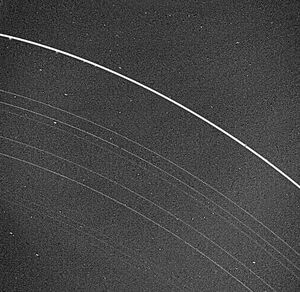
Uranus' rings, thin and dark
Uranus is the 7th planet in our Solar System, the third gas / largest planet. Like all gas planets, the copious amounts of gas causes wind speeds of hundreds of km/h.
It is the only planet in our Solar System that rotates on its side, meaning its axis is less than 45 degrees to horizontal.
Composition
Uranus, just like Jupiter and Saturn, is primarily made out of hydrogen and helium, the difference being that a considerable minority (2.3%) is made out of methane, which is much more than the rest of the atmosphere that isn't hydrogen or helium on Jupiter, Saturn or even Neptune. [1]
The upper most clouds are made out of ammonia and hydrogen clouds, the middle clouds are made out of ammonium hydrosulfide and the lowest clouds are made out of water vapor. This exact same composition can be found on every gas planet in our Solar System.
Deep into the atmosphere of Uranus, the extreme pressures may break appart the methane molecules into carbon, which rain down as diamonds.
Beyond that comes the mantle, which is a liquid mess of water, ammonia and methane ices. The core is rocky and small, made out of iron and nickel, unlike the 3 other gas planets. [2]
Moons
Uranus has 27 moons, but almost none that are mainstream-popular, like Triton, Europa, Io or Ganymede.
The moons are named after characters in Shakespear's plays, some are from old english literature, with an exception for Margaret.
The moons, especially the largest, are very dark, smaller and lighter than our Moon and are primarily out of rock and ice. [3] The largest and most "popular" moons are Titania, Oberon, Umbriel, Ariel and Miranda.
Rings
Uranus has rings, however, they are thin and dark. Unlike Saturn, which as long, thick, visible rings, Uranus appears to have lines. This, however, can be changed if one views it in forward-scattered light.
Uranus has 13 rings: 1986UR, 6, 5, 4, and . They reach out from a couple thousand km to as far as around 90,000 km. Nowhere near Saturn distances, but we can't really compare something like Uranus' rings to the magnificence of Saturn.
Uranus's rings are composed of macroscopic particles and dust. In fact, there are multiple dust bands inbetween various rings, as well as 1986UR and being known as dusty rings. [4]



